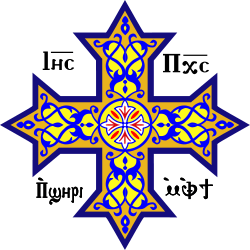Pope Julian of Alexandria
| Saint Julian of Alexandria | |
|---|---|
| 11th Pope of Alexandria & Patriarch of the See of St. Mark | |
| Papacy began | 18 March 178 |
| Papacy ended | 17 March 188 |
| Predecessor | Agrippinus |
| Successor | Demetrius |
| Personal details | |
| Born | Egypt |
| Died |
17 March 188 Alexandria, Egypt |
| Buried | Baucalis, Alexandria |
| Nationality | Egyptian |
| Denomination | Coptic Orthodox Christian |
| Residence | Saint Mark's Church |
| Sainthood | |
| Feast day | 17 March (8 Paremhat in the Coptic Calendar) |
Pope Julian (Yulianus) of Alexandria, 11th Pope of Alexandria & Patriarch of the See of St. Mark. He is commemorated in the Coptic Synaxarium on the 8th day of Paremhat.[1]
There was a man who was a wise priest, and had studied the books of God, and his name was Julian; and he walked in the path of chastity and religion and tranquillity. So a body of bishops of the synod assembled, together with the orthodox laity, in the city of Alexandria, Egypt, and searched among the whole people, but could find none like this priest. So they laid their hands upon him, and appointed him patriarch. He composed homilies and sermons on the saints; and he continued in the see ten years. After this patriarch, the bishop of Alexandria did not remain always in that city, but issued thence secretly, and ordained priests in every place, as Saint Mark, the evangelist, had done. Julian went to his rest on the 8th of Paremhat, or on the 12th of Babah, as some say, in the fifth year of the reign of Septimius Severus the prince.
References
- General
- Meinardus, Otto F.A. (2002). Two Thousand Years of Coptic Christianity. American University in Cairo Press. ISBN 978-977-424-757-6.
- Atiya, Aziz S. The Coptic Encyclopedia. New York: Macmillan Publishing Co., 1991. ISBN 0-02-897025-X
External links
- The Official website of the Coptic Orthodox Pope of Alexandria and Patriarch of All Africa on the Holy See of Saint Mark the Apostle
- Coptic Documents in French
| Preceded by Agrippinus |
Pope of Alexandria 178–188 |
Succeeded by Demetrius I |
